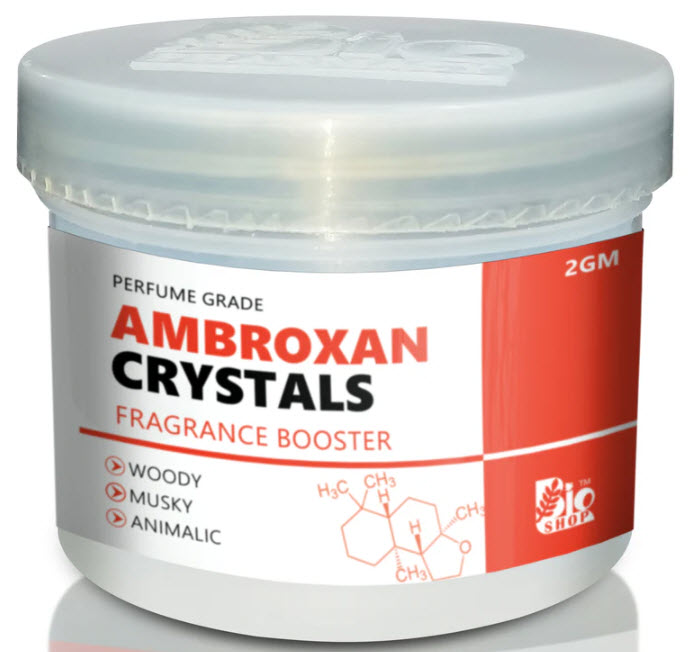Ambroxan (chemical name: Ambroxide) is a synthetic aroma chemical widely used in modern perfumery. It is celebrated for its unique, ambery, and musky scent, which adds depth, warmth, and sensuality to fragrances. Below is a detailed explanation of Ambroxan, including its properties, uses, and significance in perfumery.

1. Chemical Structure and Properties
- Chemical Name: Ambroxide
- IUPAC Name: (3aR,5aS,9aS,9bR)-3a,6,6,9a-tetramethyldodecahydronaphtho[2,1-b]furan
- Molecular Formula: C₁₆H₂₈O
- Molecular Weight: 236.39 g/mol
- Appearance: A white crystalline solid or a colorless to pale yellow liquid.
- Odor: Ambery, musky, woody, and slightly marine with a velvety, skin-like quality.
- Solubility: Insoluble in water but soluble in alcohol and oils, making it suitable for use in perfumes and cosmetic formulations.
- Boiling Point: Approximately 120°C (248°F) at 0.1 mmHg.
- Stability: Stable under normal conditions but can degrade under strong acids, bases, or UV light.
2. Discovery and Development
Ambroxan was first synthesized in the 1950s by Firmenich, a leading fragrance and flavor company. It was initially created as a cost-effective alternative to natural ambergris, a rare and expensive material derived from sperm whales. Over time, Ambroxan gained popularity for its unique scent profile and versatility in modern perfumery.
3. Role in Perfumery
Ambroxan is a versatile fragrance ingredient with several key roles:
- Base Note: It is often used as a base note in perfumes, providing a long-lasting, warm, and ambery foundation.
- Blending Agent: It harmonizes well with other amber, musky, and woody notes, creating a balanced and complex scent profile.
- Enhancer: It enhances the overall structure of a fragrance, adding depth, warmth, and sensuality.
- Fixative: It helps stabilize and prolong the scent of a perfume by slowing down the evaporation of more volatile components.
4. Fragrance Profile
Ambroxan contributes the following olfactory characteristics to a perfume:
- Ambery: Adds a rich, resinous, and slightly sweet undertone.
- Musky: Imparts a soft, skin-like, and velvety quality.
- Woody: Provides a smooth, cedarwood-like warmth.
- Marine: Creates a subtle, oceanic, and slightly salty effect, enhancing the overall projection of the fragrance.
5. Common Uses in Perfumes
Ambroxan is a staple in many fragrance families, including:
- Amber Fragrances: It is a key component in amber perfumes, particularly those featuring warm, resinous, and sweet notes.
- Musky Fragrances: Its soft and skin-like qualities make it ideal for musky and sensual compositions.
- Woody Fragrances: It enhances the earthy and resinous notes in woody compositions.
- Modern Fragrances: Its unique and multifaceted scent profile makes it popular in avant-garde and niche perfumery.
6. Safety and Regulation
Ambroxan is generally considered safe for use in cosmetics and fragrances when used within recommended concentrations. Key points include:
- IFRA Compliance: The International Fragrance Association (IFRA) sets guidelines for the maximum allowable concentration of Ambroxan in different product types to ensure safety.
- Allergen Potential: It is not classified as a significant allergen, but it is always recommended to conduct patch tests to ensure it does not cause adverse reactions in sensitive individuals.
7. Advantages in Perfumery
- Versatility: It blends well with a wide range of fragrance materials, including ambers, musks, and woods.
- Longevity: Its fixative properties help prolong the lifespan of a perfume on the skin.
- Diffusion: Its radiant and airy qualities enhance the overall projection and sillage of a fragrance.
- Cost-Effectiveness: As a synthetic ingredient, it is more affordable than natural alternatives with similar scent profiles.
8. Limitations
- Overuse: Due to its popularity, it can be overused in some fragrances, leading to a generic or “synthetic” smell.
- Regulatory Restrictions: Compliance with IFRA and EU regulations may restrict its use in certain formulations.
9. Example Perfumes Featuring Ambroxan
Ambroxan is found in numerous iconic fragrances, including:
- Molecule 02 by Escentric Molecules: A minimalist fragrance that features Ambroxan as the sole ingredient, showcasing its unique scent profile.
- Baccarat Rouge 540 by Maison Francis Kurkdjian: Enhances the ambery and musky accords.
- Dior Sauvage: Complements the fresh and spicy notes.
10. Conclusion
Ambroxan is a fundamental aroma chemical in modern perfumery, prized for its ambery, musky, and woody characteristics. Its ability to act as a base note, fixative, and enhancer makes it indispensable in creating warm, complex, and long-lasting fragrances. While it is generally safe, its potential for overuse necessitates careful formulation and adherence to regulatory guidelines. Its versatility and unique scent profile ensure its continued prominence in the fragrance industry.